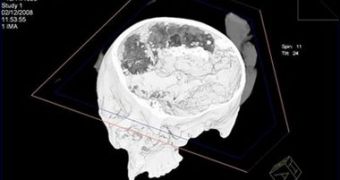A group of archaeologists from the UK have unearthed an ancient skull that dates back from the Roman invasion, 2,000 years ago. Surprisingly, the head of the unlucky person it used to belong to was not buried along with the body, but that's not the oddest part. When she was attempting to clean the discovered skull, finds officer Rachel Cubbitt, a dig team member of the York Archaeological Trust, felt something moving inside. When she gazed at the inner part of the skull through its base, she saw a yellow substance that turned out to be the remains of a brain.
The finding was made during excavation works at Heslington East, where University of York's campus expansion site lies. The skull was buried in a muddy pit, with no trace of the rest of the body discovered in the area, which is peculiar, and suggestions claim that this was some sort of ritual burial or sacrifice. The experts are still puzzled by the fact that the brain tissue, although shrunken, has managed to resist for such a long time when no other soft tissue did.
"The survival of brain remains where no other soft tissues are preserved is extremely rare," shared Sonia O'Connor, research fellow in archaeological sciences at the University of Bradford in a statement, quoted by Discovery. "This brain is particularly exciting because it is very well preserved, even though it is the oldest recorded find of this type in the UK, and one of the earliest worldwide."
Philip Duffey, a neurologist at York Hospital, who scanned the skull, claimed that "It will be very important to establish how these structures have survived, whether there are traces of biological material within them and, if not, what is their composition," as cited by Live Science.
Contrary to what some news reports announced, this is not the oldest brain tissue ever found. That record belongs to some that are about 8,000 years old and were discovered buried in a peat bog in Windover Farms, Florida, US, back in 1986. Other old tissues, approximately 5,200 years of age, were found in the glacier-preserved Iceman mummy, but the top of the list is held by the blood vessels that belonged to a T-Rex that lived around 70 million years ago.

 14 DAY TRIAL //
14 DAY TRIAL //